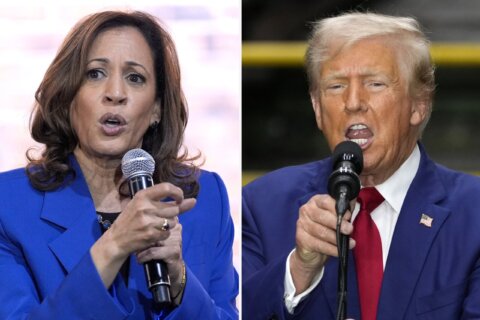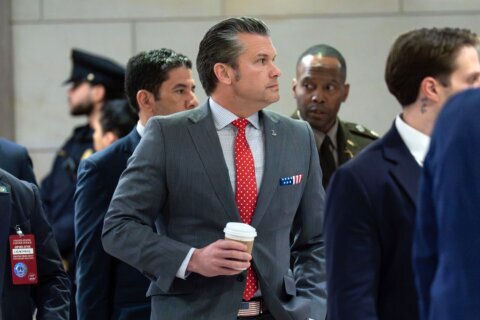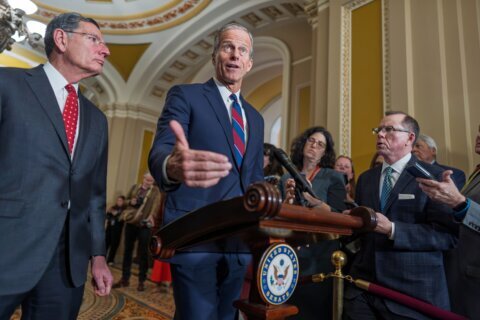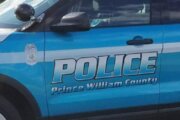This article was republished with permission from WTOP’s news partners at Maryland Matters. Sign up for Maryland Matters’ free email subscription today.
This article was written by WTOP’s news partners at Maryland Matters and republished with permission. Sign up for Maryland Matters’ free email subscription today.
With less than a week until early voting begins in Maryland, voting rights advocates say they’ll be keeping an eye out for voter confusion and intimidation as voters head to the polls in what promises to be an unconventional general election.
Several voting rights groups told Maryland Matters what they are focused on and their concerns, as the Nov. 3 election looms.
Fighting voter confusion
Voter confusion is at the top of Maryland Common Cause Executive Director Joanne Antoine’s concerns as in-person voting begins. She worries that some voters, confused by the state’s switch from regular polling locations to larger voting centers, will head to their usual polling location on Election Day.
“We’re expecting a lot of people to, unfortunately, just kind of wake up the day before Election Day or on Election Day,” Antoine said. “And they’re finding out that their regular polling location isn’t open.”
Fearing a massive shortage of election workers state officials opted to open roughly 320 in-person voting centers across the state instead of the usual 1,800 or so neighborhood polling locations.
Antoine said Common Cause has spent months educating voters about this change, but said she still expects some voters will turn up at their usual neighborhood polling site on Election Day.
She said that many local election boards plan to put signs at former polling locations to direct confused voters to larger in-person voting centers designated for this general election.
For the state’s Oct. 26 to Nov. 2 early voting period, most regular early voting centers will be open, as will a few additional locations around the state.
Antoine said she expects that long lines will be unavoidable in some of the state’s larger jurisdictions, particularly toward the end of the early voting period and on the Nov. 3 Election Day.
“We’re preparing for lines in places like Prince George’s and Baltimore City,” Antoine said. “I think there’s just no way around it, even with these locations open all throughout the counties.
Registering last-minute voters
Emily Scarr, director of Maryland PIRG, said she has been working to help young and first-time voters navigate the registration and ballot casting process. Casting a ballot for the first time can be daunting, even without the added pressure of the COVID-19 pandemic.
Now that the state’s Oct. 13 voter registration deadline has passed, Scarr said she is focused on educating eligible voters about Maryland’s same-day registration process. If voters opt for same-day registration, they must present a document showing proof of residency when they arrive at an in-person voting location.
“I’ve found, for my 15 years of doing this work, that people intend to vote,” Scarr said. “And if they have access, they will vote. It’s really about removing barriers that make it harder for folks to vote. It’s great that Maryland no longer has the arbitrary voter registration deadline, so that people will take advantage of being able to show up with proper identification, and vote.”
She said the coronavirus pandemic and moving college classes online has eliminated the way her organization usually reaches many young voters: by standing outside of college dining halls and speaking to them in-person. Now they are relying largely on networking with students whom they know to get the word out.
Scarr said she can’t be sure what voter turnout will look like, but said she expects a “large turnout, if not a record turnout” based on interest shown in the election. She said it’s difficult to estimate turnout because the election is being conducted under such unusual circumstances.
Ashley Oleson, director of the League of Women Voters of Maryland, said she couldn’t speculate on voter turnout, but said her organization has been fielding a lot of questions from voters on statewide ballot issues and judicial elections.
“I think people are really understanding now, at least from our perspective, that everything on the ballot is important, and they want to be sure that they’re ready,” Oleson said.
Scarr is particularly interested in how younger voters turn out for the election. She thinks a large turnout of young voters in this election could form a pattern in future elections.
“Voting is habit forming,” Scarr said. “The future of our democracy is dependent on young people being encouraged and welcomed into the system. Young voters have the largest share of the electorate, but have historically had lower turnout than older populations. We do know that if you know we make it easy and accessible for young people to participate, they will.”
Combating voter intimidation
Fears of voter intimidation soared after President Trump urged his supporters to watch the polls “very carefully” during the first presidential debate.
At least one instance of alleged voter intimidation has been recorded in Maryland already. Earlier this month, a Frederick County resident with a yard sign supporting Democratic presidential nominee Joe Biden reportedly received a letter warning that “If you are a Biden-Harris supporter, you will be targeted.”
Police and the U.S. Secret Service are investigating the letter, which also threatened the lives of Biden and his running mate, U.S. Sen. Kamala D. Harris (D-Calif.).
State and local officials have taken steps to quell worries about voter intimidation: Montgomery County officials said local police would adjust their routes to include ballot drop box locations, and last week Maryland Attorney General Brian E. Frosh (D) issued a stern warning against voter intimidation – a federal and state crime that can lead to a $5,000 fine and up to five years in prison.
Common Cause and the League of Women Voters plan to keep a keen eye on in-person voting centers during early voting and on Election Day. Antoine said about 400 volunteers will look for any signs of trouble at in-person polling centers during early voting and on Nov. 3 as part of the nonpartisan Election Protection coalition.
“There is a great chance in certain parts of the state that we might see some activity outside of the polls, that might come off as intimidating to a lot of voters,” Antoine said.
She said the Election Protection volunteers aren’t poll watchers or challengers, but will spend time outside polls and report any instances of voter intimidation.
Antoine said she doesn’t think voter intimidation will be widespread in the state, but urged voters to remain vigilant as they head to the polls.
Oleson said Election Protection roving volunteers will also be looking for issues seen in the June 2 primary, such as long lines and lack of accessibility at the polls.
“They’re going to be driving by poll centers to see if there are lines or any issues and things like that, and helping to report those things, so that they can also coordinate with local boards or the state board of elections to get any issues resolved,” Oleson said.
Assistant U.S. Attorney Leo J. Wise, a seasoned anti-corruption attorney, was tapped last week handle complaints over voter intimidation of fraud in the state. Wise can be reached at 410-209-4800. Marylanders with concerns over voter intimidation can also reach the attorney general’s office at 443-961-2830 or toll free at 833-282-0960, or by email at electionswork@oag.state.md.us.
This article was written by WTOP’s news partners at Maryland Matters and republished with permission. Sign up for Maryland Matters’ free email subscription today.







